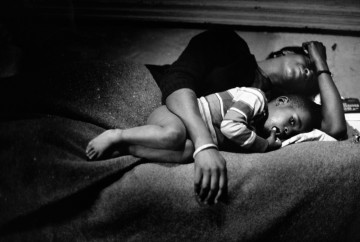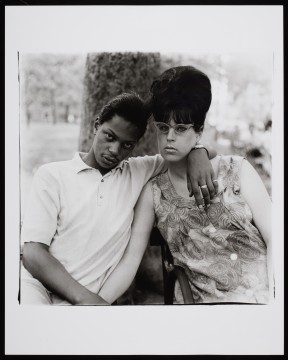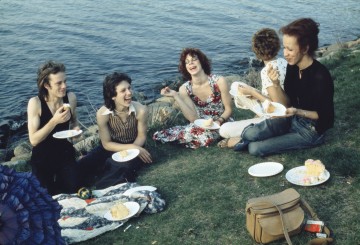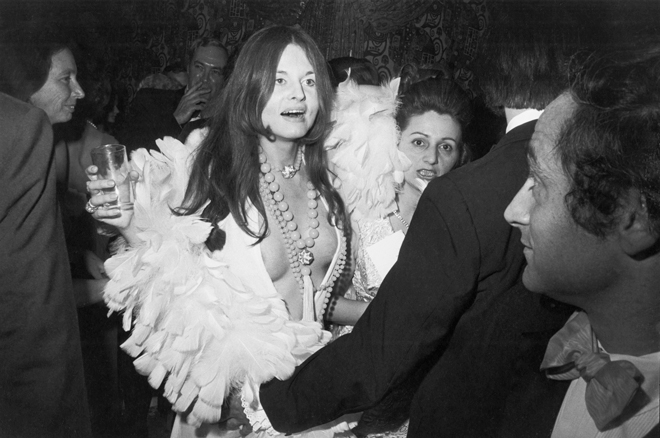I’m a bit of a voyeur. One of my favourite things to do is seeing a person and trying to imagine what their lives are actually like. My roommate and I used to do this at the airport in university for hours waiting for standby flights. Was this family approaching us happy? Was this couple having an affair and using a conference in Miami as a ruse to fool their spouses? Was this woman with the flowers landing in Halifax to visit her sick father at the hospital? We would never know but it was an amazing way to pass the time and let our imaginations go.
This is why I love looking at photographs. One picture can lead you to compose a story in your head that could go on forever. And that’s why the latest exhibit at the AGO is one that I think really can’t be missed. The stories filling my head after going through the Outsiders exhibit were endless.
From March 12 – May 29, The Art Gallery of Ontario is showing Outsiders: American Photography and Film – 1950s – 1980s. I was lucky enough to get a walk-through of the exhibit which features works from six unique photographers as well as short films from six additional photographers from the 50s to the 80s. The images in the show changed the way that Americans saw themselves. They broadened the lens to reflect a more authentic look at the diversity of the times.
I am so thankful that the exhibition runs to the end of May because it gives me a chance to go back a few times. I haven’t stopped thinking about it since I went. The exhibit asks you to think about ‘Where do you belong?’ And I kept that in mind as I went through.
To me, some of the most powerful images came from Gordon Parks, the first black photographer for Life Magazine. He documented the Fontenelles family of Harlem over the summer of 1967. This image of Bessie and her son Richard stopped me.
At first glance, isn’t this you and me? Isn’t this an exhausted mother lying with her son, willing him to sleep just a little bit longer?

Gordon Parks
Bessie and Little Richard the Morning
After She Scalded Her Husband,
Harlem, New York, 1967
1967
gelatin silver print
11×14
Courtesy of The Gordon Parks
Foundation and Nicholas Metivier
Gallery
© The Gordon Parks Foundation.
Then you read the title and then you hear the story and you realize that there is so much to it. It leads you to the Fontenelle family’s story of poverty, tragedy and hopelessness.
It also makes you think about Parks, the man behind the lens. How did he feel capturing these images? Did he debate about showing the realities of poverty in the city that were largely ignored or did he want to thrust it into the face of the largely white, middle-class Life readers?
And if you’re anything like me, you’ll be Googling the crap out of the Fontenelle family and to see what their life became after being the central family in a ground breaking photo essay. The sheer amount of information will confirm to you how important this work is.
Another photographer in the exhibition is Diane Arbus. Many of her photographs are close to their subjects and focus closely on their faces which I love.

Diane Arbus A young man and his pregnant wife in Washington Square Park, N.Y.C., 1965. Gelatin silver print 50.8 x 40.6 cm (sheet) Private collection, Toronto. Copyright © The Estate of Diane Arbus.
What struck me was that her shots are like today’s popular Humans of New York series except better because although they come titled, in the exhibit they aren’t explained. To be able to gaze at their faces and imagine what their lives were like was awesome. I could easily spend an hour in front of that one wall in the Arbus room.
The final room of the exhibit, for me, was the most intimate. A few of the images in Nan Goldin’s space have the photographer as the subject. I’m not able to show the one of her gazing at the man leaving her bed but it brought tears to my eyes. I’ve been there. I’ve been that outsider wondering if this man felt the way I did or wondering if it would again end in failure. All of this is in her eyes.

Nan Goldin Picnic on the Esplanade, Boston 1973 cibachrome 57.2 x 77.5 cm Matthew Marks Gallery © Nan Goldin, 2016
Not all of her work are self-portraits. This image of a picnic in Boston has stuck with me as well. Don’t you want to be there? Haven’t you been there? Laughing with your friends over a bottle of wine. Gossiping. Debating. You feel a kinship to the image until you realize the courage it took for these men to get there. And that this isn’t today, this was in 1973.
And you ask yourself why are these men considered outsiders when they’re experiencing the exact same thing you do? Why close to forty-five years later would it still take courage for a group of men, who are expressing themselves, being themselves, to go on a picnic down by the lake?
The question that the exhibit asks, ‘Where do you belong?’ should be a simple answer. But it’s not. Sure you could look at the pictures and simply say, “Well, I’m fairly conventional so I’m an insider.”
What I took away is that we’re all outsiders AND insiders at some point depending the circumstance.
Like the video at the beginning said, “Aren’t outsiders just smaller groups of insiders?” I look forward to discussing this with my friends—maybe down by the lake over a picnic?
Ultimately, we’ll all have a different answer and that’s the beauty of art.
But this I can say with absolute certainty. Where do I belong? Back at the AGO and back at this exhibit. It’s really incredible.
*Main Image: Garry Winogrand, Centennial Ball, Metropolitan Museum, New York, 1969. Gelatin silver print, printed c. 1976, 35.6 x 43.2 cm (sheet). Purchase, with funds generously donated by Martha LA McCain, 2015. 2014/1313 © The Estate of Garry Winogrand, courtesy Fraenkel Gallery, San Francisco.*
This post was sponsored by the AGO, but the opinions are my own.

Leave a Reply